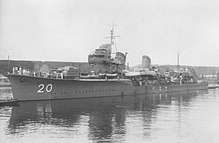Japanese destroyer Sagiri
Sagiri (狭霧, "Haze")[1] was the sixteenth of twenty-four Fubuki-class destroyers, built for the Imperial Japanese Navy following World War I. When introduced into service, these ships were the most powerful destroyers in the world.[2]
 Sagiri under way on 10 August 1936. | |
| History | |
|---|---|
| Name: | Sagiri |
| Ordered: | 1923 Fiscal Year |
| Builder: | Uraga Dock Company |
| Yard number: | Destroyer No. 50 |
| Laid down: | 28 March 1929 |
| Launched: | 23 December 1929 |
| Commissioned: | 31 January 1931 |
| Stricken: | 15 January 1942 |
| Fate: | Sunk by HNLMS K XVI on 24 December 1941 |
| General characteristics | |
| Class and type: | Fubuki-class destroyer |
| Displacement: | |
| Length: |
|
| Beam: | 10.4 m (34 ft 1 in) |
| Draft: | 3.2 m (10 ft 6 in) |
| Propulsion: | |
| Speed: | 38 knots (44 mph; 70 km/h) |
| Range: | 5,000 nmi (9,300 km) at 14 knots (26 km/h) |
| Complement: | 219 |
| Armament: |
|
| Service record | |
| Operations: |
|



History
Construction of the advanced Fubuki-class destroyers was authorized as part of the Imperial Japanese Navy's expansion program from fiscal 1923, intended to give Japan a qualitative edge with the world's most modern ships.[3] The Fubuki class had performance that was a quantum leap over previous destroyer designs, so much so that they were designated Special Type destroyers (特型, Tokugata). The large size, powerful engines, high speed, large radius of action and unprecedented armament gave these destroyers the firepower similar to many light cruisers in other navies.[4] Sagiri, built at the Uraga Dock Company was the sixth in an improved series, which incorporated a modified gun turret which could elevate her main battery of Type 3 127 mm 50 caliber naval guns to 75° as opposed to the original 40°, thus permitting the guns to be used as dual purpose guns against aircraft.[5] Sagiri was laid down on 28 March 1929, launched on 23 December 1929 and commissioned on 31 January 1930.[6] Originally assigned hull designation "Destroyer No. 50", she was commissioned as Sagiri.
The 4th Fleet Incident occurred only a year after her commissioning, and Sagiri was quickly taken back to the shipyards for strengthening of her hull.
Operational history
On completion, Sagiri was assigned to Destroyer Division 20 under the IJN 2nd Fleet. During the Second Sino-Japanese War, from 1937, Sagiri covered landing of Japanese forces in Shanghai and Hangzhou. From 1940, she was assigned to patrol and cover landings of Japanese forces in south China.
World War II history
At the time of the attack on Pearl Harbor, Sagiri was assigned to Destroyer Division 20 of Desron 3 of the IJN 1st Fleet, and had deployed from Kure Naval District to the port of Samah on Hainan Island.[7]
From 17 December, Sagiri covered Japanese landings at Miri and at Kuching in Sarawak.[8] On 24 December 1941, approximately 35 nautical miles (65 km) off Kuching, Sagiri was torpedoed by the Dutch submarine HNLMS K XVI. Her aft magazine caught fire and exploded, sinking the ship with the loss of 121 of her crew.[9][10] Some 120 survivors were rescued by her sister ship, Japanese destroyer Shirakumo.
On 15 January 1942, Sagiri was removed from the navy list.[6]
Notes
- Nelson. Japanese-English Character Dictionary. page 602
- Globalsecurity.org. "IJN Fubuki class destroyers".
- Fitzsimons, Illustrated Encyclopedia of 20th Century Weapons and Warfare p.1040
- Peattie & Evans, Kaigun page 221-222.
- F Fitzsimons, Illustrated Encyclopedia of 20th Century Weapons and Warfare (London: Phoebus, 1977), Volume 10, p.1040.
- Nishidah, Hiroshi (2002). "Fubuki class 1st class destroyers". Materials of the Imperial Japanese Navy. Archived from the original on 2012-07-11. Retrieved 2009-03-08.
- Nevitt, Allyn D. (1997). "IJN Sagiri': Tabular Record of Movement". Long Lancers. Combinedfleet.com.
- L, Klemen (1999–2000). "The Invasion of British Borneo in 1942". Forgotten Campaign: The Dutch East Indies Campaign 1941-1942. Archived from the original on 2015-04-01.
- D’Albas. Death of a Navy: Japanese Naval Action in World War II.
- Brown. Warship Losses of World War II
References
- D'Albas, Andrieu (1965). Death of a Navy: Japanese Naval Action in World War II. Devin-Adair Pub. ISBN 0-8159-5302-X.
- Brown, David (1990). Warship Losses of World War Two. Naval Institute Press. ISBN 1-55750-914-X.
- Howarth, Stephen (1983). The Fighting Ships of the Rising Sun: The Drama of the Imperial Japanese Navy, 1895–1945. Atheneum. ISBN 0-689-11402-8.
- Jentsura, Hansgeorg (1976). Warships of the Imperial Japanese Navy, 1869–1945. US Naval Institute Press. ISBN 0-87021-893-X.
- Nelson, Andrew N. (1967). Japanese–English Character Dictionary. Tuttle. ISBN 0-8048-0408-7.
- Watts, Anthony J (1967). Japanese Warships of World War II. Doubleday. ISBN 978-0-3850-9189-3.
- Whitley, M J (2000). Destroyers of World War Two: An International Encyclopedia. London: Arms and Armour Press. ISBN 1-85409-521-8.
External links
- Nevitt, Allyn D. (1997). "IJN Sagiri: Tabular Record of Movement". Long Lancers. Combinedfleet.com.
- Nishidah, Hiroshi (2002). "Fubuki class destroyers". Materials of the Imperial Japanese Navy. Archived from the original on 2012-07-11. Retrieved 2009-03-08.
- Globalsecurity.org. "IJN Fubuki class destroyers".